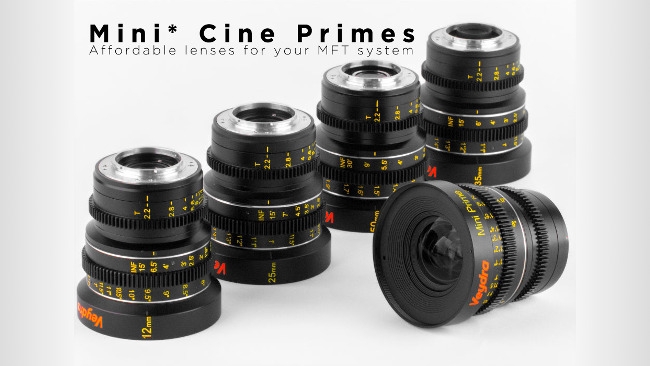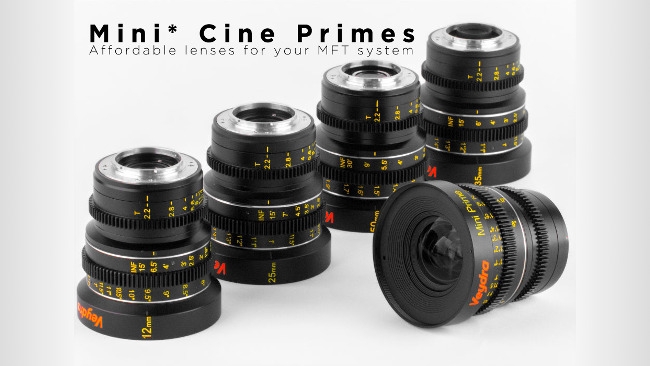
 Veydra Mini Cine Prime Lenses for MFT
Veydra Mini Cine Prime Lenses for MFT
Do you have a micro four-thirds system and a desire to shoot with video-oriented lenses? Is your budget on the smaller side, but forgiving enough to invest in a nice set of cine prime glass? If you answered "yes" and "yes," today is your lucky day, because a modest startup by the name of Veydra may have answered your prayers.
After a successfully-funded kickstarter campaign (544% backed), Veydra has created its first set of (mini) cine prime lenses for the direct use with the micro four-thirds system. The Veydra primes sell individually (12, 16, 25, 35, 50, and 85mm) or come in a four-piece set with a hard case (16, 25, 35, 50mm). These lenses are a full-metal construction, feature a 2.2 T-Stop and have a 0.8 cinema pitched gear for both iris and focus rings. Additionally, the lenses exceed 4K image resolving and feature longer focus throws to ensure smooth and accurate focus-pulling techniques.
The Veydra set's best and most practical feature is that every lens has an 80mm outside diameter. This allows you to swap lenses effortlessly without having to readjust your follow focus or reconfigure your rig setup. Following this trend, Veydra has ensured that each lens has the same inner diameter filter thread of 77mm. This will allow you to apply a circular ND, UV, or color filter to your lenses without having to fiddle with various adapter rings from one lens to the next.
Why MFT Primes?
One would speculate Veydra's primes are targeted at the ever-popular Panasonic GH4 user group. I'll admit, at first glance I shied away from the thought of investing heavily into the micro four-thirds system. Yet, as I grow in my career, I am getting hired more frequently for my work with the GH4 then any camera system I've used in the past. The camera is the embodiment of every style of shooting I undertake (corporate, TV, documentary, cinema, aerial) and companies will opt for me to use this system because it's proven across multiple platforms. To me, I believe what Veydra is doing here is giving the entry level shooter a taste for cine primes and providing a solid kit of glass that becomes a reliable workhorse in the field.
It is the process of democratization that changes the landscape of the tech industry. If Veydra can provide quality glass at an affordable rate, it will shift the playing field, opening new opportunities and workflows for users to capitalize on. Why MFT primes, though? Aside from the obvious ergonomics, why not continue to use still photography lenses? Lastly, why not invest in a set of super 35 primes as opposed to a smaller MFT image circle?
These are a lot of questions to tackle, but let's take a quick look at some of these issues. "Why MFT primes?" Well, if you are working with a MFT system and you are trying to work as fast as possible, having a native mount without having to fiddle with adapters is probably the best way to go about ensuring a smooth production. If you are constantly changing from Nikon to Canon to PL mount throughout a shoot, chances are if it's a fast moving environment, you're going to miss a shot. Having a native mount will streamline your process and ensure for a hassle-free affair.
Let's say you're like me and you have a gorgeous set of Nikon Nikkor primes. Until recently, I was really unaware of the finer points in optics and multicoats. Aside from the obvious ergonomics of primes, when shooting with my Nikkors, I would see slight color shifts occurring from lens to lens. This is because the muticoats were all designed separately at different points in time for each lens. The chemical balances on the glass might be similar or vastly different from one another, depending on their line. This will cause you to color correct a little more aggressively in post, matching hues and tints as your lens selection changes.
Why Veydra?
The great thing about the Veydra primes is that they all were designed within the same time frame of one another and thus the chemical processing should match. This is quite liberating, allowing you to color across the board, instead of trying to match shot for shot. The other reason you want to select cine primes over a still photography lens is because of 'focus breathing'. When shooting video with still photography lenses and rack/pulling focus, you might see the optics slightly change the field of view as your focus plain shifts. This is because the lens is "breathing" and the optics are moving ever so slightly, effectively shifting your field of view. To the trained eye, this can appear amateurish and distracts from the subtle characteristics of established cinema standards. With the Veydra's however, you are not plagued with this shift and your field of view will remain unaffected as you change your focus plane.
Understanding a crop factor is one thing, but grasping the idea of what that crop does for your image is something else entirely. So, this brings us to our last question, "Why a MFT image circle vs. a super 35mm circle?" The Veydra primes are built from the ground up to be telecentric to the sensor. This means the subtle characteristics of the lens, including edge-to-edge sharpness, bokeh, distortion etc., are all tailored to the MFT system. When I shoot with my 35mm glass without a speed booster, I am punching into the center of the image circle. Subtle characteristics of edge fall off and bokeh on the wide ends of each lens are lost because the sampling is happening dead center to the oversized image circle. To some, this might be a "whatever" factor, but as you grow as a cinematographer, characteristics like this play an integral part in your cinematic approach. You can throw a speed booster onto the back of your lens, but when you do this, you are introducing slight chromatic fringing to your image and the optics are still not native to the sensor and mount.
Conclusion
So, with all these factors in play, Veydra has offered a great set of primes to the budding cinematographer, all at an affordable cost! If you're like me and have adopted the micro four-thirds system for your own work, you might want to take a hard look at this set. I know I would like to put my hands on these at my local rental shop and put them through their paces. These lenses really appear to be a great buy and most certainly will elevate your image to newfound heights.
For a direct example please take a look at this test from our friends over at The Camera Store. So how do you feel about shooting with native lenses on the MFT system? Share your thoughts and experiences down below!
Tags: Production


Comments